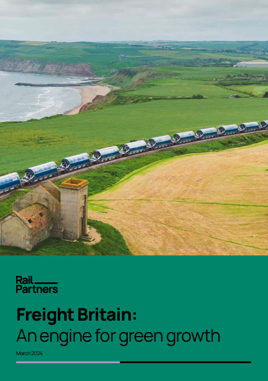Freight operators are ready to invest in new trains, facilities and in skills, providing the Government offers support to help the market grow.
A new report issued by Rail Partners has issued five policy recommendations including a call for Government to address the widening cost gap between rail and road freight, to help businesses choose rail over more polluting transport modes.
‘Freight Britain: An engine for green growth’ offers a route map to delivering on the Government’s 75% rail freight growth target and securing important economic and environmental benefits for a nation of rail freight customers.
Rail Partners, the trade body representing independent passenger and freight operating companies, has outlined how operators will work in partnership with Government to deliver the economic and environmental benefits of freight, through investment in trains, its workforce, and new technologies.
Its report follows a commitment from the Department for Transport to grow rail freight by 75% by 2050. The report offers a route to delivering on that target – and securing the benefits freight brings to the economy and the environment.
Andy Bagnall, chief executive, Rail Partners, said: “Rail freight operators want to invest in better, greener trains and freight facilities, to do so they need Government to work in partnership with them and create a favourable environment for growth.
“That means providing confidence around access to the network and investment in capacity, and commitments to support rail freight as a critical step towards wider environmental targets and net zero.”
He added: “Increasing rail freight services has the backing of all the main parties, so Government should have the confidence to invest in tangible support, from targeted infrastructure investment to the right incentives to encourage customers to switch to rail, helping to decarbonise supply chains.’
Rail Partners says that today, rail freight already contributes £2.45bn to the UK economy, with 90% of those benefits accrued outside of London and the South East.
It adds that as a result of recent investment in longer and heavier freight services, a single train can now remove up to 129 lorries from roads.
However, rail freight is facing a series of challenges including a widening gap between the cost of rail compared to road.
Rail network access charges for freight have risen sharply since 2010, while road costs have been kept down as duty on fuel has been frozen since 2014.
Freight operating companies are actively looking for opportunities to invest in growing the sector. Under the right conditions, they would commit significant resources into procuring greener rolling stock, building new and improved freight facilities across the network, and in people through driving more innovation creating more high-skilled jobs, says Rail Partners.
The report details five priority policy interventions that would create those conditions, giving rail freight operating companies the confidence to invest, and – in partnership with Government – grow the rail freight sector:
- Address the widening gap between road and rail costs to create a level playing field between freight modes. Make rail an affordable choice within a price sensitive freight and logistics sector by considering tax and incentives across modes.
- Maintain and expand already successful grant schemes to remove more lorries from roads. Further support modal shift to rail by expanding successful incentives like the Mode Shift Revenue Support scheme, which already removes 900,000 HGV movements from roads, and the Freight Facilities Grant, which works well in Scotland and could be expanded to the whole of Britain.
- Offer long term access to the rail network. Give businesses the confidence to invest in rail freight facilities, and technology, by offering certainty around future access rights to the railway.
- Provide reliable infrastructure necessary to support rail freight growth. Create space for more freight services by both maximising use of existing capacity and making clear commitments to new infrastructure.
- Deliver a reformed railway. Create a Strategic Freight Unit within any new arm’s length body to ensure freight is adequately represented. A new public body should also have a statutory duty to promote rail freight, safeguard operators and ensure freight is sufficiently prioritised.
John Smith, chief executive officer, GB Railfreight and chair of Rail Partners’ Freight Council, said: “In recent years freight operating companies have invested in facilities, talent and rolling stock to prepare ourselves for the transition to net zero. Collectively, we as an industry are able to help the UK decarbonise its supply chains and in doing so remove HGVs from our road network, which will benefit the wider country.
“With small interventions from government that provide long-term stability, further private sector investment can be unlocked that will drive the growth of rail freight across the country.”
















Login to comment
Comments
No comments have been made yet.